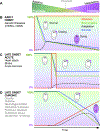Mitochondrial dynamics in adaptive and maladaptive cellular stress responses
- PMID: 29950571
- PMCID: PMC6716149
- DOI: 10.1038/s41556-018-0133-0
Mitochondrial dynamics in adaptive and maladaptive cellular stress responses
Abstract
Mitochondria sense and respond to many stressors and can support either cell survival or death through energy production and signaling pathways. Mitochondrial responses depend on fusion-fission dynamics that dilute and segregate damaged mitochondria. Mitochondrial motility and inter-organellar interactions, including with the endoplasmic reticulum, also function in cellular adaptation to stress. In this Review, we discuss how stressors influence these components, and how they contribute to the complex adaptive and pathological responses that lead to disease.
Conflict of interest statement
Authors declare that they do not have any competing interests.
Figures



Comment in
-
Focusing on mitochondrial form and function.Nat Cell Biol. 2018 Jul;20(7):735. doi: 10.1038/s41556-018-0139-7. Nat Cell Biol. 2018. PMID: 29950569 No abstract available.
References
Publication types
MeSH terms
Grants and funding
LinkOut - more resources
Full Text Sources
Other Literature Sources

